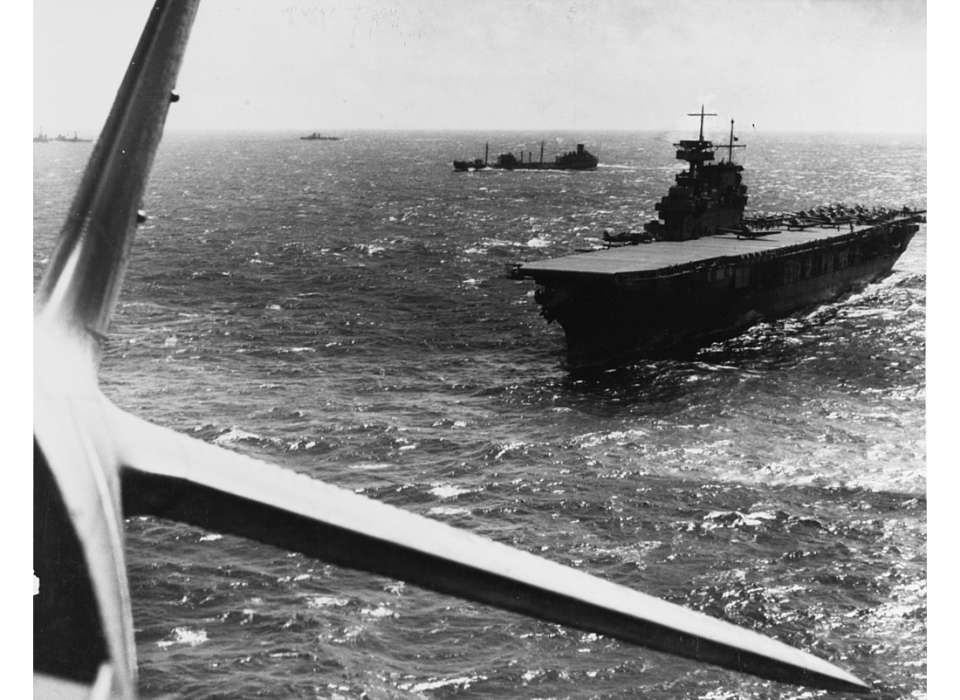Top image: USS Yorktown (CV-5) conducts aircraft operations in the Pacific sometime before the battle. A fleet oiler is in the near background. Official US Navy photograph courtesy of the US Navy Naval History and Heritage Command
At the beginning of May, 1942, the Japanese Empire was wrapping up the triumphant initial campaigns which had initiated its war in the Pacific. Practically the entire western Pacific basin was now under Japanese control.
The British had been crushed in Hong Kong, Malaya, and Borneo, ending with the humiliating surrender of Singapore in February. The vital port of Rabaul, at the tip of New Britain, had been lost in February as well, giving the Japanese a crucial base near the Solomon Islands and New Guinea. During March, the Dutch had been overwhelmed in Sumatra and Java, with their vital oilfields falling into Japanese hands.
By May, British resistance in Burma had collapsed, and their forces were in the final stages of a humiliating rout back to the Indian frontier. Meanwhile, in the Philippines, Bataan had fallen in April—the largest surrender in American history—sending 75,000 Filipino and American troops into Japanese captivity. The tiny, besieged bastion of Corregidor had lasted just a month longer, falling on 6 May.
All in all, the picture for the Allies was one of outright calamity. The Japanese held the initiative, and India and Australia both now seemed directly threatened.
The latter, in particular, was a source of tremendous anxiety to the Americans. Australia figured prominently in Allied plans to retake the Indies. Now, Japan was threatening it with outright invasion or (by moving down the line of the Solomon Islands towards Fiji, Tonga, and Samoa) by cutting off its supply lines to the United States. Either would be a disaster.
The Australians, meanwhile, were facing their gravest crisis of the war, with the Japanese practically on their doorstep. Shockingly, earlier in the year Australian Prime Minister John Curtin had turned not to Britain, but to America for military aid, knowing that Australia’s mother country was too stretched to offer effective assistance. President Roosevelt was willing to do whatever it took to secure this vital base.
Meanwhile, in Japan, senior military leaders were already looking to future operations. While an outright invasion of Australia seemed impractical, the need to firm up Japan’s new defensive perimeter, while simultaneously discomfiting the Allies, was certainly appealing. As such, controlling the town of Port Moresby, on New Guinea’s southern shore, seemed a propitious. Its large airfield would allow Japanese airpower to project over the Coral Sea as far as northern Australia. Likewise, capturing Moresby would prevent Allied bombers from attacking Japan’s own bastions at Rabaul on New Britain, and Truk in the Carolines.
Accordingly, Admiral Inoue Shigeyoshi’s 4th Fleet, which was responsible for the South Pacific, began hatching plans to launch an amphibious invasion of Port Moresby. It was obvious that fleet carrier support would be required. But Inoue was competing for scarce resources. His superior, Admiral Yamamoto Isoroku, C-in-C of Combined Fleet, wanted to employ Japan’s fleet carriers not in the south, but in the Central Pacific against Midway.
Eventually, in early April a compromise was hammered out whereby the relatively new Carrier Division 5, comprising fleet carriers Shōkaku and Zuikaku, would be sent south to Inoue. They were to be returned as soon as Operation ‘MO’ was completed, so they could participate in the Midway operation as well. Japanese warships began sortieing from Truk on 30 April.
Unknown to the Japanese, American codebreakers had broken Japan’s main operational cipher, JN-25b, and had become aware of the outline of Japanese intentions almost three weeks prior. Conveniently, a pair of American carriers—Lexington and Yorktown—had already been operating in the area since March. They duly began making their way towards the Coral Sea in order to block Japan’s invasion fleet. What the Americans didn’t know, though, was that Admiral Takagi Takeo’s carrier Striking Force of Shōkaku and Zuikaku was planning a wide loop to the east around the arc of the Solomon Islands, before turning and taking its intended position in the middle of the Coral Sea. This had nothing to do with any premonition of American carriers being in the area, but rather was aimed at Allied airpower in northeast Australia.
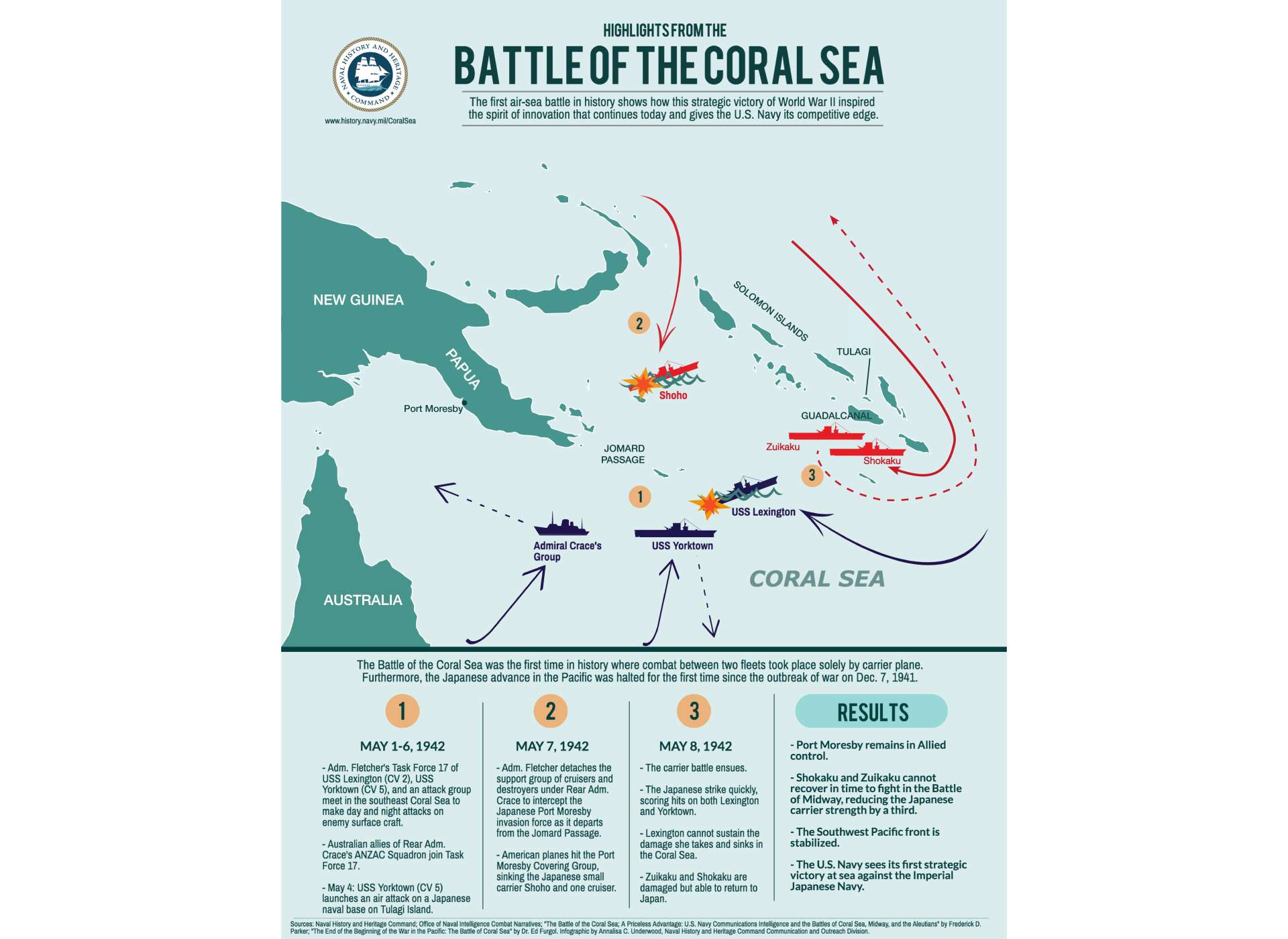
Infographic of The Battle of the Coral Sea. Courtesy of the Naval History and Heritage Command.
Thus, two carrier forces were about to be placed in close proximity to the other, without either party having any idea that the other was in the area. The stage was now set for the world’s first carrier battle.
It is worth recalling that in early 1942 the aircraft carrier was a brand-new weapon system, which had never been used in an open-ocean encounter against its opposite numbers. Both Japan and America had developed doctrine for their employment, but a lot of it was just theory at this point. Not only that, but as events would prove, aerial spotting was very tricky, over-water navigation was still primitive, communications arrangements rudimentary, coordination with land-based aircraft extremely difficult to arrange, and throughout it all, the effects of weather were wide-spread and capricious. As a result, the upcoming engagement would feature two carrier forces groping around like blind men much of the time, punctuated with extreme violence once they finally came to grips.
On 3 May, the Japanese opened proceedings by capturing the tiny island of Tulagi in the Solomon Islands. VAdm Frank Jack Fletcher, the senior American commander, moved north with Yorktown that night, and launched an attack on the Japanese invasion forces the following morning. Though the results were fairly minimal, the Japanese were shocked to realize that American carriers were in the area. Takagi’s flattops, though, were still far to the north at this time, and in no position to intervene.
By the 5th, Fletcher had retired south from his Tulagi raid to refuel and meet up with Lexington (who had just finished refueling itself). Takagi was by now rounding the tip of the Solomons and heading into the Coral Sea. The Japanese now knew American carriers were somewhere in the area. The Americans, on the other hand, still assumed that any Japanese flattops covering the anticipated landings would be coming down directly from the north, past Rabaul, and would thus be off to their northwest.
On the 6th, when sighting reports came in of two Japanese carriers near Bougainville, those suspicions seemed confirmed. Fletcher began heading WNW, intending to strike on the 7th. He was unaware that Takagi’s pair of fleet carriers were now very close indeed, and almost closing in from behind him! At one point in the evening, unbeknownst to either Takagi or Fletcher, both forces were a mere 70nm from each other.
On the morning of the 7th, Fletcher received more sightings of two carriers and four heavy cruisers off to his northwest, closing on the Jomard Passage through the Louisiades. He duly launched a powerful strike of 50 aircraft from Lexington at 0930, followed shortly by 43 aircraft from Yorktown. Simultaneously he dispatched a surface action group under Australian RAdm John Crace to physically block the Jomard Passage, and be in position to clean up anything that might make it past the upcoming carrier strike.
Simultaneously, Takagi’s pair of flattops had also sent up scout planes at dawn. At 0722, one of them radioed that it had detected a target to the southwest: an enemy carrier, a cruiser, and three destroyers. Shōkaku and Zuikaku began turning into the wind at 0815, launching a powerful strike of 78 aircraft.
Both sides, though, were shortly to become grimly aware of just how poor their scouting actually was.
When the American aircraft arrived off Deboyne Island, instead of finding two heavy carriers, they encountered the brand-new light carrier Shōhō. Her role was providing air support during the invasion itself, and she was thus well in advance of the transports of the main Japanese landing force. In light of the fact that by 4 May Admiral Inouye and 4th Fleet knew there were American carriers in the area, it seems almost incredible that a ship as valuable but vulnerable as Shōhō should have been ordered to continue moving south on the evening of the 6/7.
The Americans took full advantage of this mistake. With just five Japanese combat air patrol (CAP) fighters overhead, and her quartet of cruiser escorts not sufficiently close for effective anti-aircraft fire, Shōhō never stood a chance. In the space of twenty-five minutes, she was punished with seven torpedo and as many as thirteen bomb hits. Devastated and afire from stem to stern, Shōhō shortly took her final plunge, sinking by the bow with 631 of her crew. Only a pitiful 131 survivors were left bobbing in the Solomon Sea.
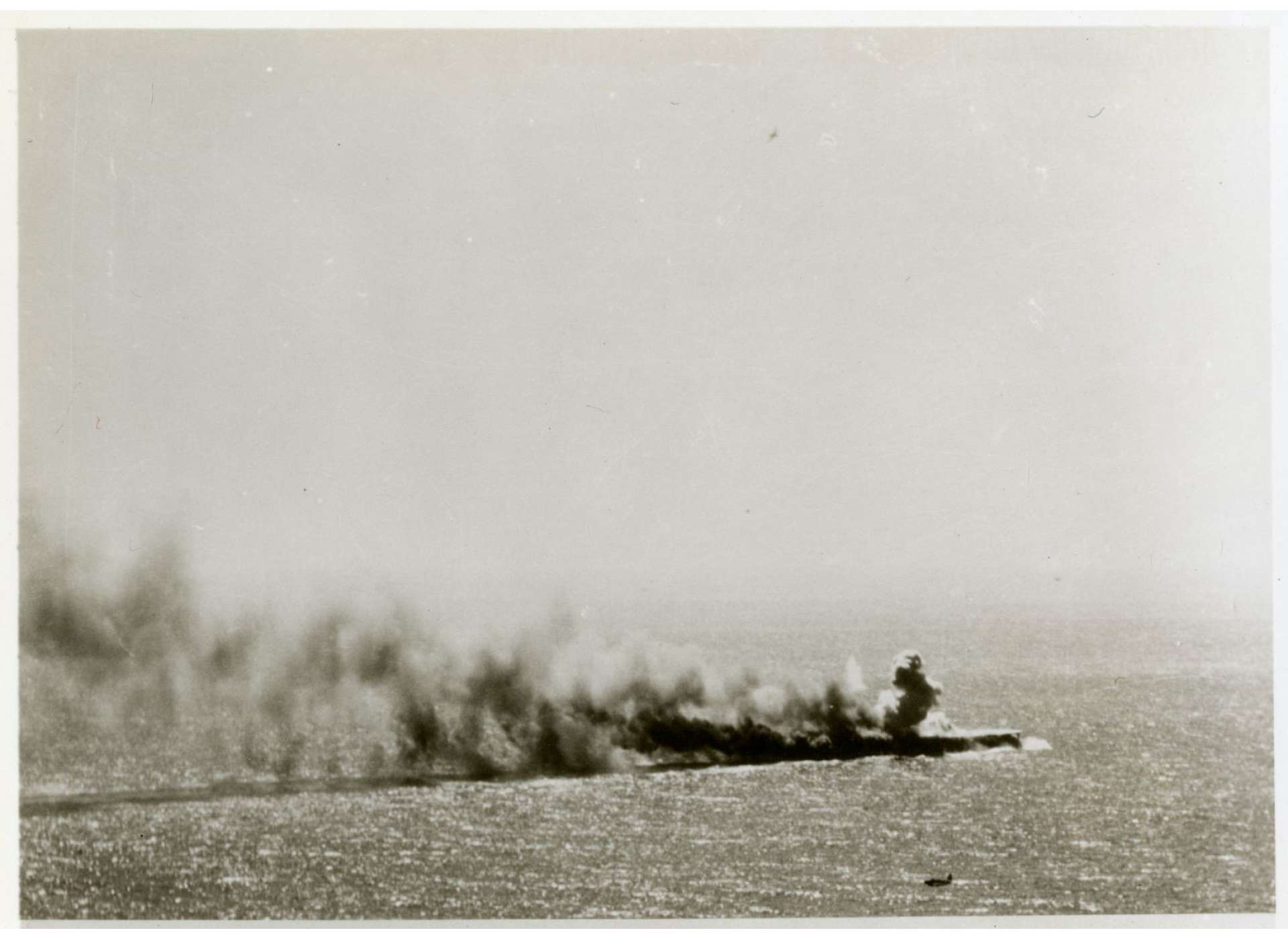
Smoke billowing from Japanese Carrier SHŌHŌ, Photo courtesy of The National WWII Museum, Gift in memory of Sgt. Lyle E. Eberspecher, 2013.495.381
For the U.S. Navy, which had been living on a diet of almost complete military failure for the past five months since Pearl Harbor, smashing an enemy carrier was a welcome catharsis. “Scratch one flattop!” was the exultant message one American aviator sent back to Fletcher. The slow transports of the Japanese invasion force, seeing the pillar of smoke on the southern horizon marking Shōhō’s fiery demise, came about and temporarily fled to the north to put distance between themselves and Fletcher.
Meanwhile, Takagi’s morning strike force had arrived at its own target, only to discover that the enemy “carrier” was in fact the fast fleet oiler Neosho and her escort, the destroyer Sims. The Japanese searched the immediate neighborhood for another two hours looking for worthier victims. None were to be found—Fletcher’s carriers were by now far to the northwest. Finally, with fuel running low, the Japanese aircraft returned and vented their disgust on the hapless American duo. Sims was sunk outright, with very heavy loss of life. Neosho, though badly hit by seven bombs and a crashing Japanese aircraft, was buoyed by her load of fuel oil, and proved much tougher to put down. Though left dead in the water, American damage control would manage to keep her afloat for four more days.
Meanwhile, the afternoon had also seen ground-based bombers dispatched from Rabaul’s airbases to attack Crace’s surface force, to no effect. A final desperation attack at dusk by a picked force of Takagi’s best pilots failed to find the American carriers, and only succeeded in subtracting eight Japanese aircraft from his roster.
The two carrier forces were by now close enough that as the sun set the Americans could detect Japanese high-frequency homing beacons for their aircraft, and were able to observe some of Takagi’s landing operations via radar over the horizon to the northeast. As night fell on the 7th, the Americans were now well aware that Japanese fleet carriers lurked nearby. For Takagi, the unwelcome news was that the Americans were now between him and the vulnerable Japanese transports in the invasion force. 8 May would clearly be a day of decision.
Though Fletcher knew that the Japanese had been basically to his northeast at nightfall, dawn saw him launching an all-round search just to cover all his bases. At the same time, the Japanese began searching to their south and southwest. The Japanese found the Americans at 0800; the Americans found the Japanese twenty minutes after that. Fletcher began launching 75 aircraft at 0857; the Japanese sent up 69 half an hour later.
In the following encounter, the Americans were aided by the fact that both their ships carried radar, whereas the Japanese did not. This gave Fletcher more warning time to get his combat air patrol fighters into action. However, fighter direction was another area where the Americans at this point had very little practical experience, with the result being that the Japanese attack wasn’t really blunted.
Beginning at 1113, both American carriers came under attack. Yorktown received a bomb hit, and a near miss that opened her seams, leaving a sheen of glittering fuel oil now trailing in her wake. Lexington—longer and less maneuverable than her smaller companion—had the worst of it, collecting two bombs and two torpedo hits. However, she seemed to shrug these off, and at the end of the attack was still steaming at 24 knots.
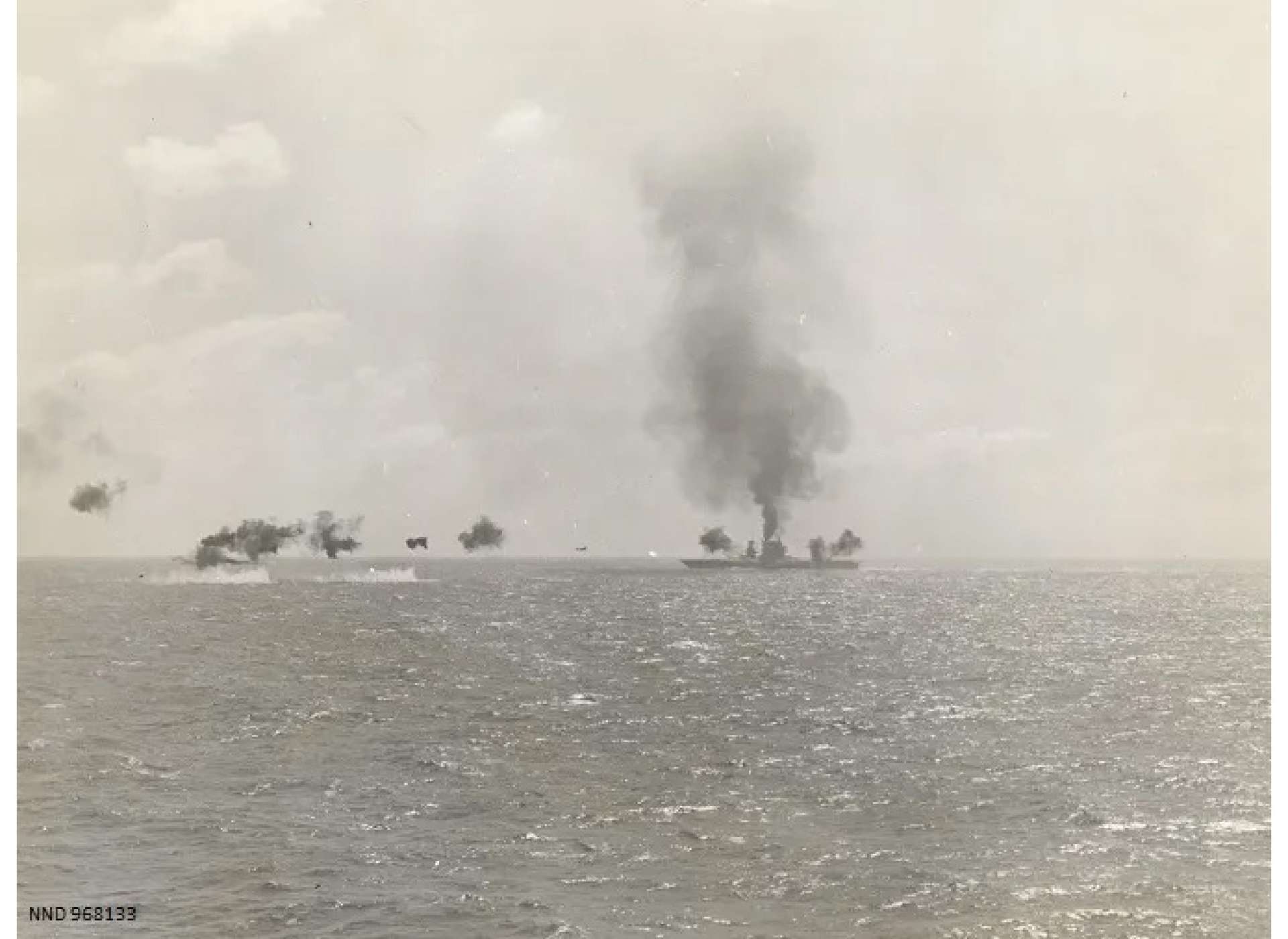
The USS Lexington after the initial torpedo hits. A Japanese torpedo plane is approaching from the left. Official US Navy photograph courtesy of the National Archives and Records Administration.
Just fifteen minutes earlier, the Japanese had taken their own lumps, with the American strike force locating and attacking Takagi’s duo. Zuikaku managed to scoot out of the way under a rain squall. But her sister Shōkaku was heavily hit by three 1,000lb bombs, which made a shambles of the fore and aft extremities of her flight deck. Heavily on fire, unable to recover aircraft, and with 223 men dead or wounded, she was ordered to retire at high speed. Later that afternoon, Zuikaku began recovering both carriers’ planes. Losses had been heavy—only 46 of the original 69 Japanese aircraft returned, and of these a dozen were so badly damaged that they were pushed over the side. Takagi’s aviators were confident, though, that they had sunk one American carrier and left another so badly damaged that its demise was certain. Takagi, convinced he had won the battle, prematurely turned north.
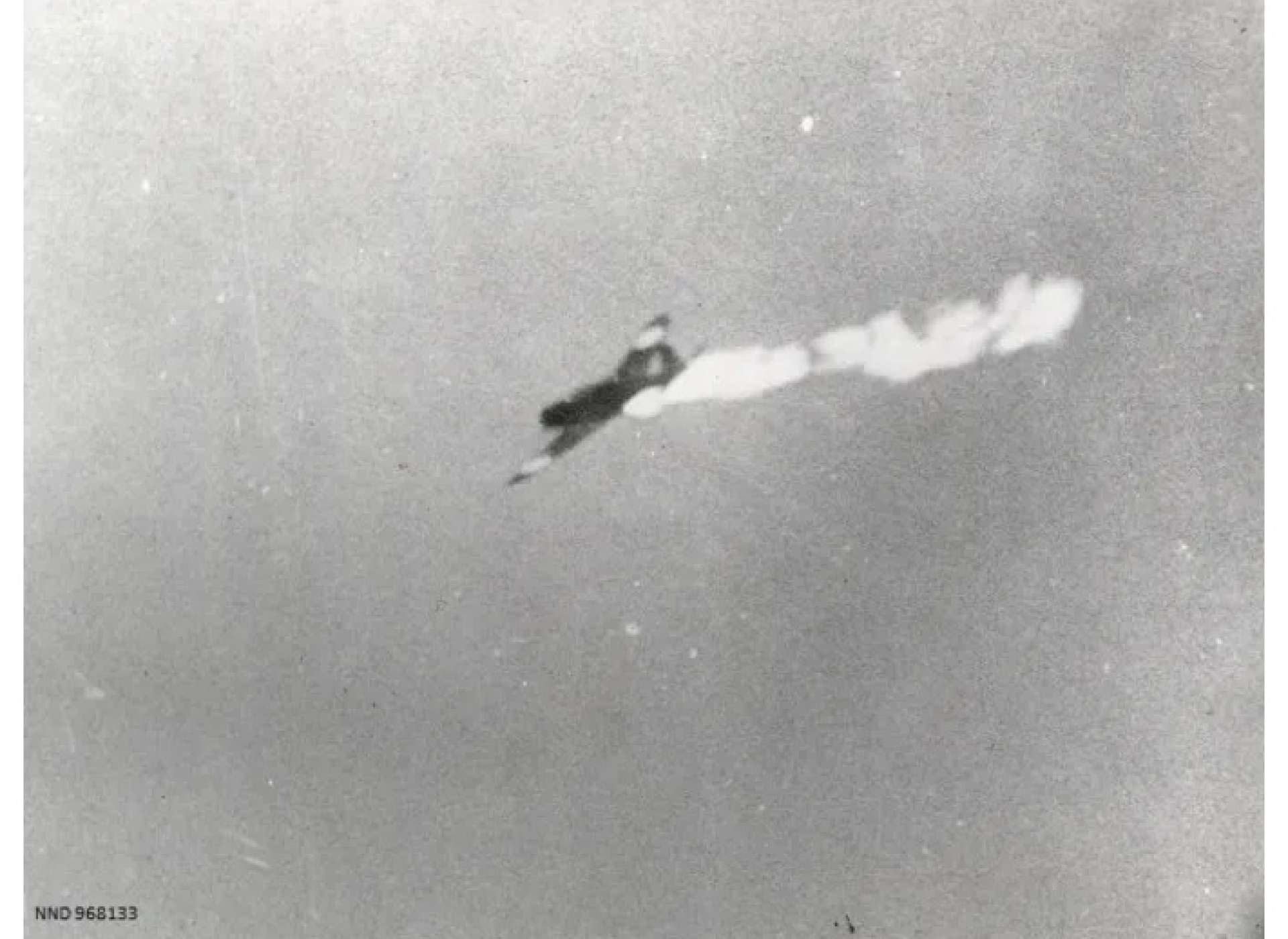
Japanese airplane after being hit by American fire. Photo courtesy of the National Archives and Records Administration.
The Americans, for their part, had already turned south to break off as well. At 1247, as a result of cracked aviation fuel tanks, Lexington had suffered an ominous explosion belowdecks. At 1355 she signaled tersely “Fires not out.” In fact, they were much worse than not out. At 1442, a monstrous detonation occurred, followed at 1512 by a second. Fires shortly raged unchecked throughout her hangar deck. At 1707 her crew was ordered off, and she was scuttled shortly thereafter.
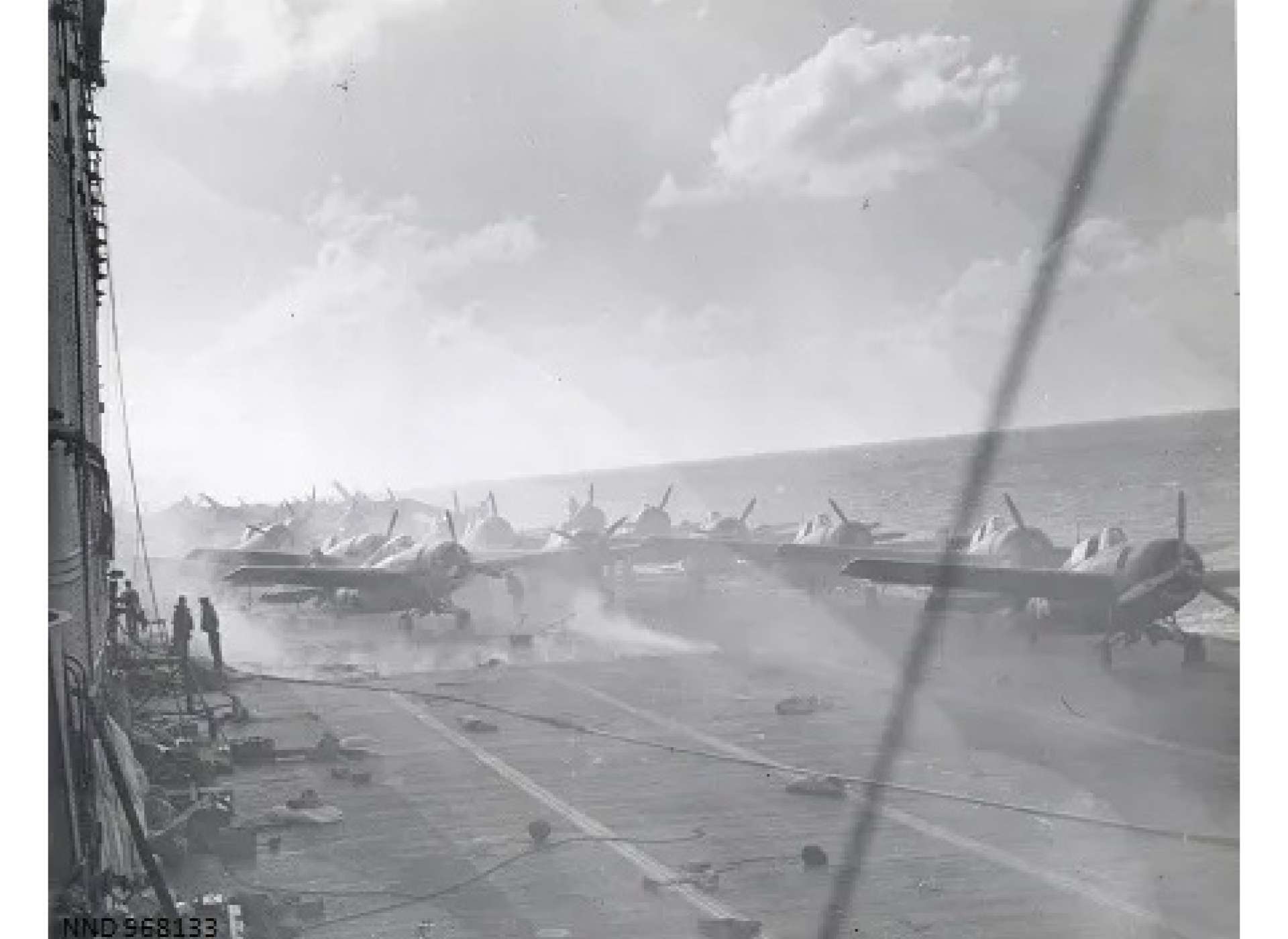
Deck of the Lexington just prior to the explosion, sometime after 1400 hours by which time all planes had been landed. Photo courtesy of the National Archives and Records Administration.
Yorktown, though in no danger of sinking, was badly damaged enough that she could no longer fight effectively. She began heading towards Pearl Harbor as best she could manage. The battle was over.
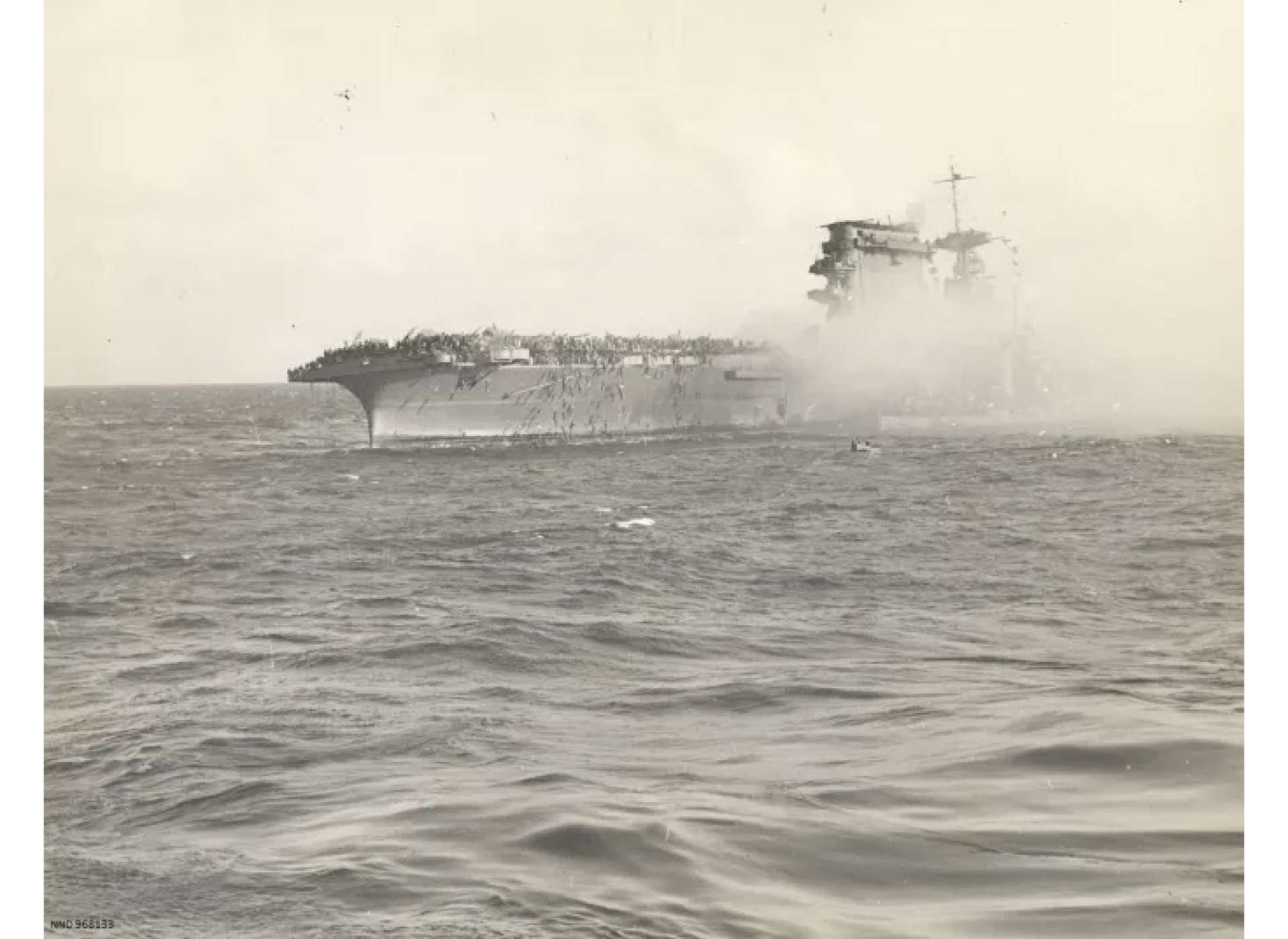
Lifeboats evacuating crew from USS Lexington. Photo courtesy of the National Archives and Records Administration.
For the Japanese, both the loss of Shōhō and the failure to capture Moresby were seen as regrettable, but not much more than a setback. Destroying (so they thought) two enemy fleet carriers for a light carrier was certainly a fair trade. For the Americans, the loss of gallant Lexington for the much smaller Shōhō was not greeted with happiness by either Admiral Chester Nimitz (the Pacific Fleet’s commander in chief), or his boss, Admiral Ernest King.
Time would reveal, though, that the Battle of Coral Sea was a strategic victory for the Allies, in that it preserved Port Moresby. More important, it had an outsized effect on the much more-important upcoming operation aimed at Midway. Shōkaku was heavily damaged; Zuikaku’s air group had been shot to pieces. As it would develop, temporarily losing the services of these two carriers at Midway was probably much more important than permanently losing Lexington, because it deprived the Japanese the opportunity of wiping out America’s remaining carriers at a stroke. That these temporary losses had been suffered in support of what was clearly a sideshow shows how muddled Japanese strategic thinking had already become.
In the end, the Battle of Coral Sea has often been overshadowed by the events a month later at Midway. Yet it stands on its own as a very important contest. It was the world’s first carrier-vs.-carrier battle, and the first naval battle in which neither side’s ships sighted the others. This in itself marked the coming of a new mode of naval warfare that had been predicted by airpower advocates as much as a decade prior.
Beyond matters of technology, at the strategic level, Coral Sea marks the division line between the first phase of the Pacific War—which had seen nothing but Japanese triumphs—and a new second phase which would be much more bitterly fought. The Japanese had been served fair warning that the U.S. Navy’s carriers were capable opponents, that the days of easy pickings were over, and that the Americans would fight ferociously to preserve Australia’s supply lines. Coral Sea also was the first carrier battle fought in proximity to the heretofore-unknown island of Guadalcanal; it would not be the last.
Jonathan Parshall
Jonathan Parshall saw his interest in the Imperial Japanese Navy develop early in his childhood.
Cite this article:
MLA Citation:
APA Citation:
Chicago Style Citation:
